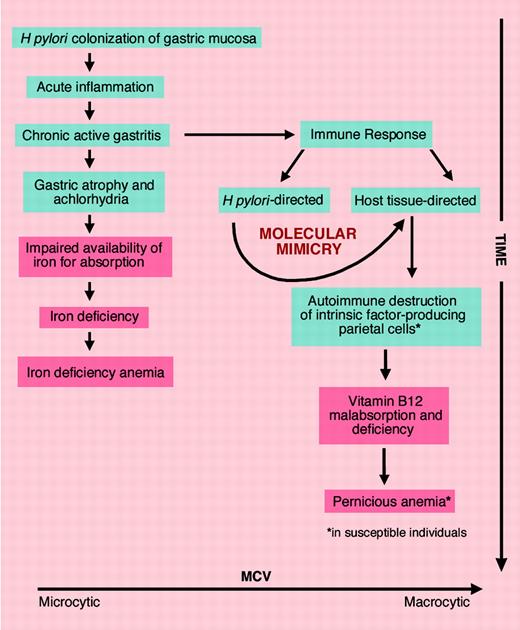Comment on Hershko et al, page 1673
Could it be that microcytic iron deficiency anemia and macrocytic pernicious anemia have a common underlying etiology? In this issue of Blood Hershko and colleagues provocatively link some cases of both disorders to Helicobacter pylori–associated gastritis.
Helicobacter pylori, the spiral Gram-negative bacillus unrecognized a quarter-century ago,1 now seems to be popping up everywhere. Its cover broken, H pylori is now incriminated in peptic ulcers, gastric carcinoma, and mucosa-associated lymphoid tissue (MALT) lymphomas. In the limelight of this year's Nobel Prize for Physiology and Medicine and with a journal named for and dedicated to its study, it appears that the previously cryptic pathogen is perhaps also responsible for some part of the global burden of anemia. Hershko and colleagues, in this issue of Blood, present circumstantial but compelling evidence derived from a cohort of patients with atrophic gastritis and marked hypergastrinemia that strongly implicates prior H pylori infection as a possible trigger of autoimmune gastritis in individuals so predisposed. Exactly how this occurs is not clear, but it likely involves a form of molecular mimicry in which the H pylori organism evades host immunity by adorning itself with a camouflage of antigenic epitopes normally worn by the cells and molecules of its host—notably the H+K+-ATPase protein on gastric parietal cells.2 In a host susceptible to subversion of the normal self-tolerance barrier, immune attack intended for the invader becomes a cause of friendly-fire casualties.
Progressive autoimmune tissue destruction ultimately results in pernicious anemia through a failure of intrinsic factor production by parietal cells, leading to abrogation of vitamin B12 absorption and consequent deficiency.3 This process may take years, perhaps even decades to develop. Hershko et al also posit that earlier during the pathogenesis of Hpylori–induced disease, chronic active gastritis leads to atrophic gastritis with achlorhydria, and this contributes to the iron deficiency diathesis in women during child bearing years. While neither of these putative causalities is new,4,5 the insightful contribution of the Hershko group lies in the stratification of their patients by 20-year age increments and their demonstration of a progressive rise in mean corpuscular volume (MCV), ferritin, and gastrin levels, with af all in B12 levels in each age interval. They also demonstrated evidence of thyroid and other autoimmune disease in a substantial proportion of their patients. Eradication of Hpylori resulted in a fall in serum gastrin.
Proposed sequence of nutrient deficiency anemias caused by H pylori. Pernicious anemia occurs in individuals predisposed to autoimmune gastric atrophy.
Proposed sequence of nutrient deficiency anemias caused by H pylori. Pernicious anemia occurs in individuals predisposed to autoimmune gastric atrophy.
The chronology of gastric mucosal damage inflicted by H pylori as visualized in this model runs from chronic active inflammation with achlorhydria and iron deficiency to autoimmune destruction with B12-deficiency caused by pernicious anemia (see figure). Such a continuum tends to blur the distinction sometimes made between Type A (autoimmune) and Type B (bacterial) gastritis.
Flushed out of obscurity now, H pylori, a pathogen that has left molecular footprints in antiquity, is now getting full attention for its potential role in kindling a gamut of cellular injuries through processes that include apoptosis, mitogenesis, mutagenesis, and autoimmune tissue damage through molecular mimicry. These processes can lead to the variety of pathologic conflagrations associated with H pylori's wily adaptation to securing safe haven within us. ▪


This feature is available to Subscribers Only
Sign In or Create an Account Close Modal